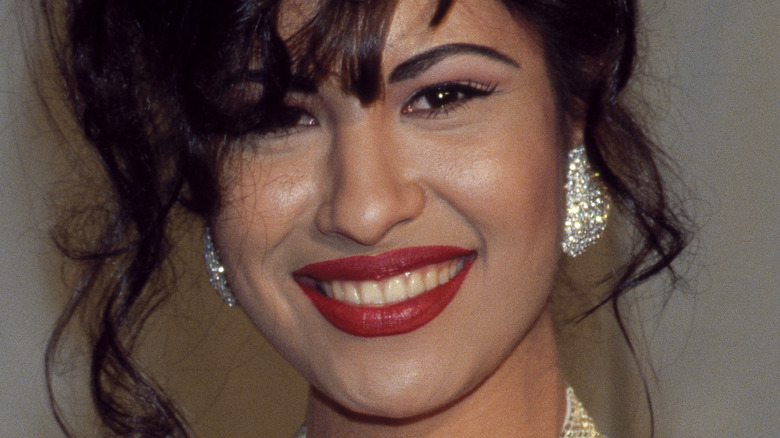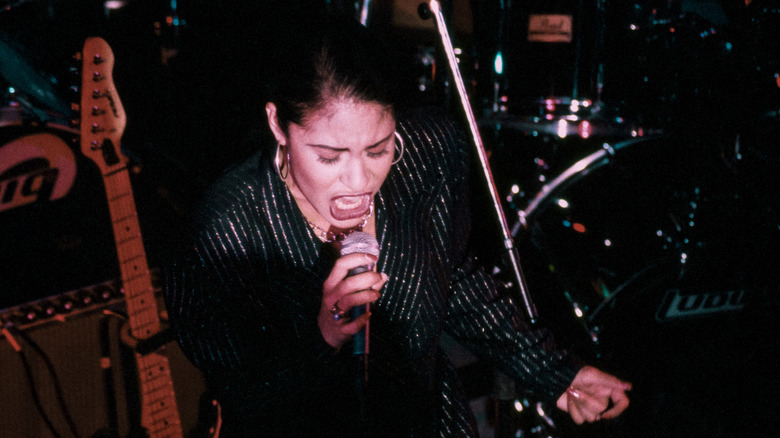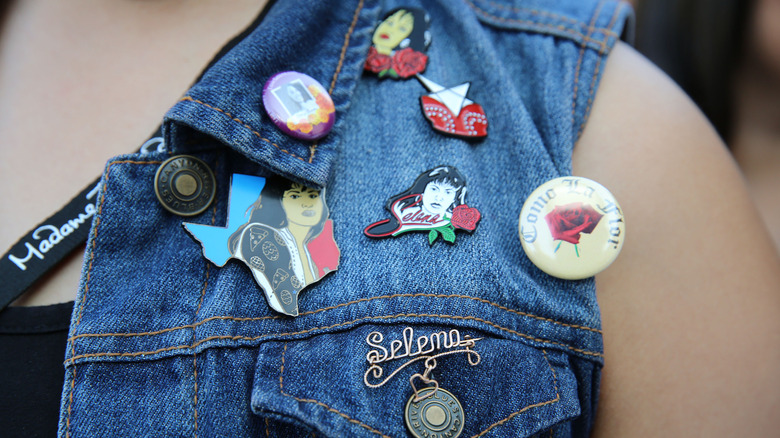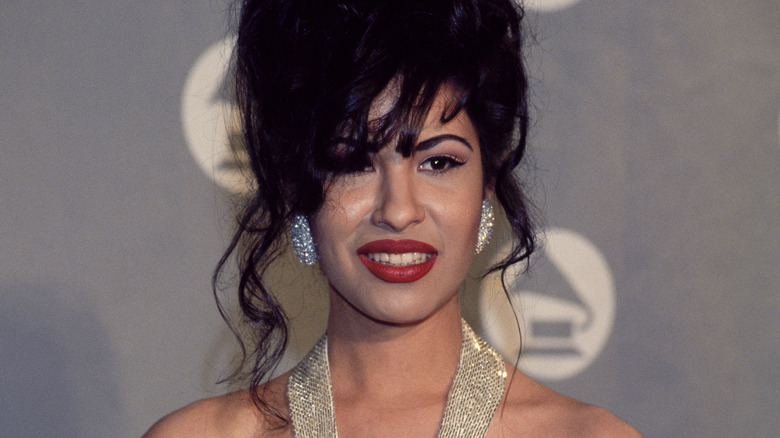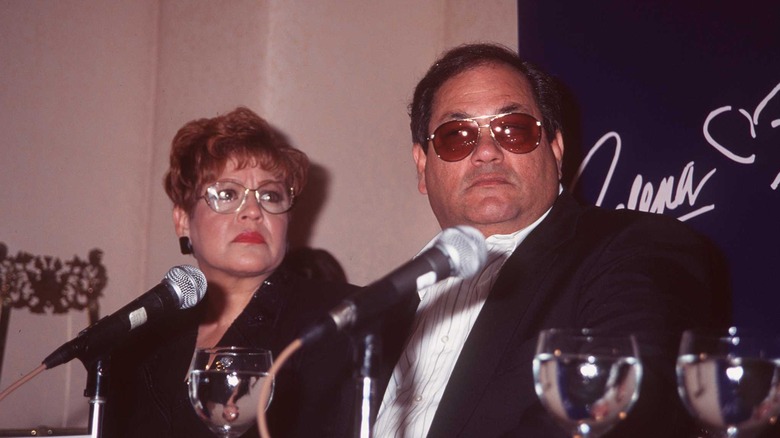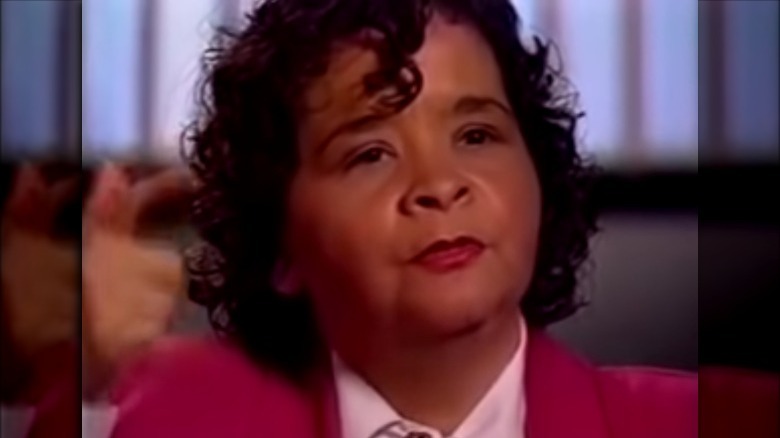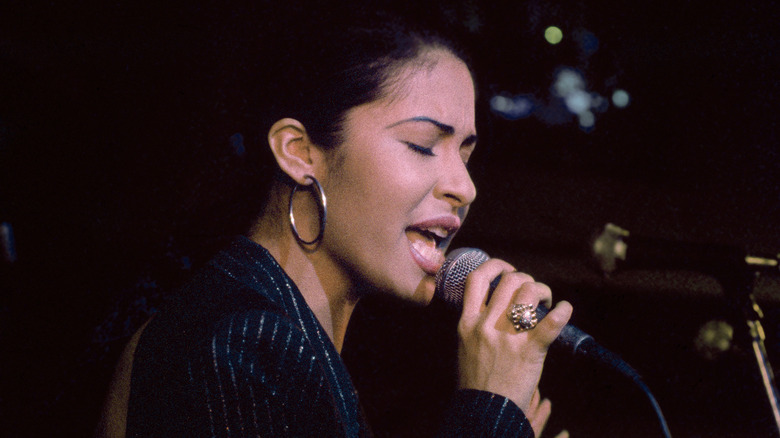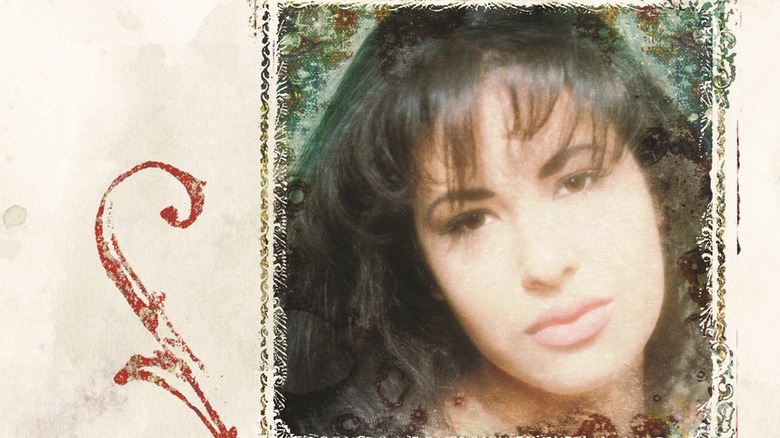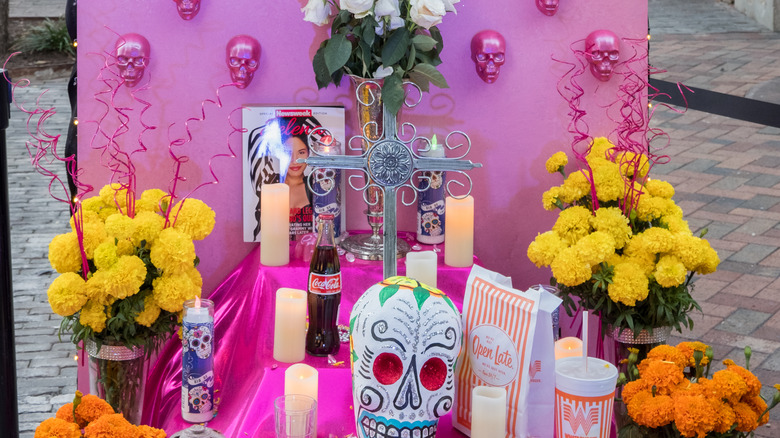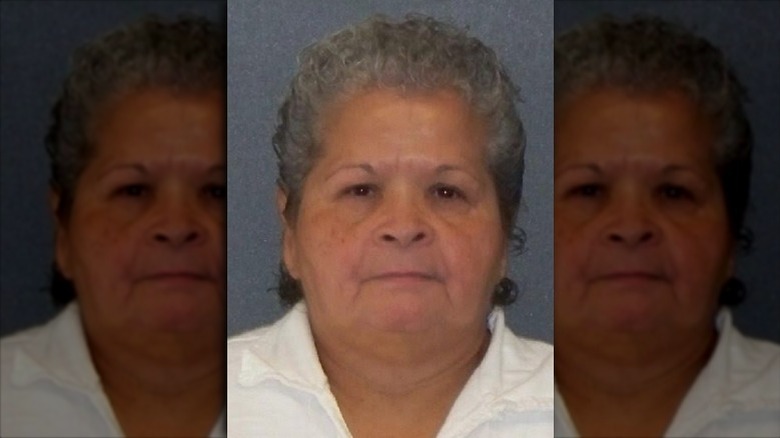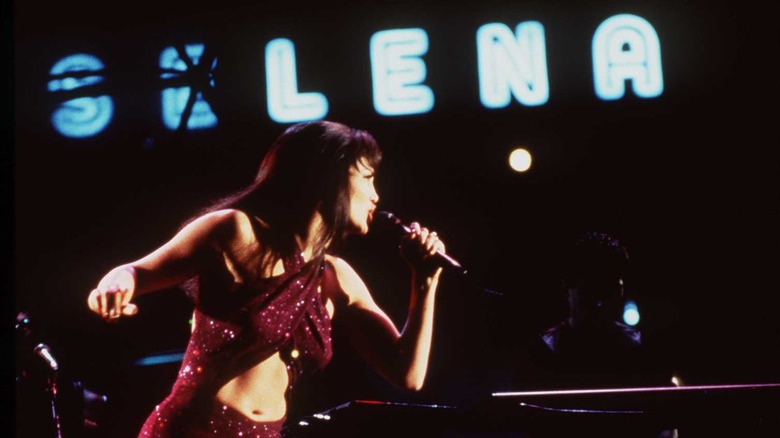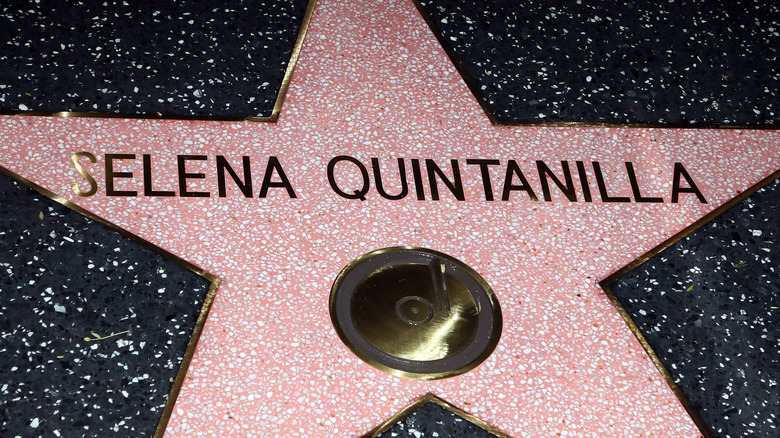The Tragic Murder Of Selena Quintanilla
Better known today by just her first name, as most legendary artists are, Selena Quintanilla-Perez is the undisputed Queen of Tejano Music and a larger-than-life musical icon whose impact has transcended generations and cultures. Born in 1971 as a Mexican-American Texan, Selena got her start in music as a little girl singing Spanish-language songs with her family band in the late 1970s and 1980s, as written by Biography. Soon becoming a recognizable artist in the Tejano music scene, Selena was about to break into mainstream pop superstardom with a crossover album in early 1995 when her life was tragically cut short. Only 23 years old and two weeks away from her 24th birthday, Selena Quintanilla was murdered on March 31, 1995, by her former fan club president and friend, Yolanda Saldívar.
Selena's devastating death at such a young age stunned millions as entire communities grieved over the loss of the Tejano singer. Here are the details leading up to and following the tragic murder of Selena Quintanilla.
The year Selena's murderer became a fan
It was 1991 when Yolanda Saldívar first saw Selena Quintanilla perform in person, as written by journalist María Celeste Arrarás in her book, "Selena's Secret: The Revealing Story Behind Her Tragic Death." Apparently, Saldívar, who was a 30-year-old registered nurse, according to MSN, wasn't even a fan when she attended that first concert in San Antonio. A country music fan, the nurse would only attend the Tejano star's show because of an invite from her niece. But once Saldívar saw the magic that was Selena onstage, she was hooked.
When the memorable show ended, Saldívar was excited to buy some merchandise to commemorate the night. At the time, though, there were no official products on sale, leading the new fan to come up with the idea of creating an official fan club. While there are conflicting stories of how fervent Saldívar's attempts to start the club were — Abraham Quintanilla, Selena's father, says he received 15 calls from Saldívar, while the nurse maintains she only called thrice — the end result was that Saldívar was given permission to found and become president of the Selena Fan Club in June 1991. With her main contact being Suzette Quintanilla, Selena's older sister, Yolanda Saldívar would not actually meet Selena until six months later, in December.
The president of the Selena Fan Club gets close to Selena and her family
Under Yolanda Saldívar's leadership, the Selena Fan Club expanded quickly, growing to thousands of members in just a few years, according to Biography. As Saldívar worked and proved her usefulness, the president of the Selena Fan Club ended up worming her way further into Selena and the Quintanilla family's lives. As told by Texas Monthly, she would constantly be at Selena's side when the singer was in or near San Antonio, acting as "Selena's eyes and ears." Impressed by the fan club president's dedication, the Quintanillas eventually would entrust Saldívar with more responsibilities.
Over the next few years, the former nurse's life came to completely revolve around Selena. From having control over the star's business checking accounts to being given a key to Selena and her husband's home, Saldívar was fully a part of the Tejano superstar's inner circle, as reported by The Washington Post. Yolanda Saldívar became someone Selena trusted, someone she confided in and took advice from. As written by D Magazine, Selena talked warmly of her friend, saying, "Yolanda was the one who encouraged me to go to college."
Saldívar gets a promotion and becomes increasingly obsessive
With a lifelong interest in fashion and beauty, it was only a matter of time until Selena Quintanilla had a go at creating her own clothing line. According to Bustle, the music icon was at the peak of her career, having just won her first Grammy Award the year before for Best Mexican-American Album, when she opened two Selena Etc. boutiques in Corpus Christi and San Antonio in 1994. The stores were must-go spots for all Selena fans, selling "Selena memorabilia and clothes, some of which were designed by Selena herself," while also offering salon services. And the appointed manager trusted to handle these boutiques? Yolanda Saldívar.
It was around the time of Saldívar's promotion that her behavior become more obviously troubling. As written by journalist María Celeste Arrarás in her book "Selena's Secret," boutique employees claimed that Saldívar was possessive over Selena, "constantly looking for ways to keep her away from others." The Washington Post reported on how Martin Gomez, the fashion designer for Selena's boutique clothing line who worked alongside Saldívar for eight months, quit his role solely because he couldn't stand working with the vindictive manager any longer. Even at home, Saldívar's obsession with Selena was a problem, with a roommate moving out after two weeks due to being "spooked" by the "shrine" Saldívar had turned the apartment into, according to Texas Monthly.
Selena's money goes missing
Despite repeated instances of Yolanda Saldívar's troubling attitude, the young and trusting Selena Quintanilla had "loyally defended Saldívar when anyone criticized her," according to The Washington Post. That is, until the singer's father was made aware of some suspicious behavior. In January 1995, Abraham Quintanilla (pictured) was informed of an issue with the fan club: Members were complaining that they'd never received any of the merchandise they were promised despite sending in their $22, as reported by Texas Monthly. Before telling Selena, Abraham started doing some quiet digging.
As D Magazine writes, several signs that Saldívar was embezzling money from the fan club and boutiques were uncovered, from unpaid bills to forged checks that Saldívar had written to herself and her family. On top of all that, it turned out that Saldívar had a history of similar behavior. She was once "accused of embezzling funds from a previous employer, and ... had defaulted on a student loan." The woman who had obsessively dedicated her life to Selena was on her way to being kicked right out of it.
Yolanda Saldívar gets fired and purchases a gun
On March 9, 1995, Selena Quintanilla, her father Abraham, and her sister Suzette confronted Yolanda Saldívar about her suspicious accounting, with Abraham declaring that he was "going to go to the police and make an investigation for embezzlement," according to UPI. Given only unsatisfactory excuses, the Quintanillas concluded that they could no longer trust Saldívar and relieved her of her duties. When she tried to show up to work the next day, Abraham kicked her out. The whole ordeal apparently pushed her to extreme measures. The very next day, March 11, Saldívar purchased a weapon, and on the 13th, after a background check, the newly fired manager was in possession of a .38-caliber pistol, according to Biography.
Despite her firing, Saldívar was able to obtain some of Selena's important financial records and, over the next few weeks, would effectively use them as leverage to stall her termination. On March 15, Selena went with her husband Chris Perez to meet up with Saldívar and collect the missing records. The meeting was bizarre, with Saldívar returning only some of the documents and also showing off her new gun (bought for "protection") to Selena. Unruffled, the Tejano star simply told her to return it, while suggesting that Saldívar could perhaps manage her upcoming stores in Mexico. The meeting seemed to have calmed Saldívar some because the gun was brought back to the store soon after.
The final days
While Yolanda Saldívar did return her gun after a brief meeting with Selena, by March 26, the woman had gone back to the gun store and repurchased the .38-caliber weapon that would be used against Selena just a few days later, according to UPI.
Still in possession of important financial documents, Saldívar asked for Selena to come alone to her room at the Days Inn to get the documents on the night of March 30. Smartly, Selena came with her husband, who waited outside while the two women talked in Room 158, as told by María Celeste Arrarás. Handing the records over, Saldívar mentioned to Selena that she had been raped in Mexico and later, while Selena was on her way home, asked to be taken to the hospital because of excessive bleeding. At the same time, the singer noticed that there were still documents missing. Another trip to the Days Inn was arranged for the next morning, but this time, Selena would go alone.
On the morning of March 31, 1995, the Queen of Tejano Music met up with Saldívar again. Tension between the two seemed to start at the hospital, where Selena called Saldívar out for lying about how much she was bleeding and showed signs of distrust. Ultimately, the hospital was unable to perform the exam needed to determine whether Saldívar had been raped, and the two women returned back to Room 158, where they began arguing.
Selena Quintanilla is murdered
Upon returning from the hospital on the morning of March 31, 1995, Selena Quintanilla and Yolanda Saldívar begin heatedly exchanging words at the Days Inn. Once again, Selena asked for her documents back, apparently trying to officially end their professional relationship, according to Texas Monthly. In response, Saldívar demanded that Selena return back a ring she was once gifted by her employees, but as the singer was pulling off the ring, the other woman was pulling out her gun.
Selena had her back to Saldívar when she was shot at 11:48 a.m. As reported by Yahoo, a maid heard Saldívar scream "B*tch!" as the singer frantically ran out of the room bleeding. As described by D Magazine, "the bullet hit a major artery, went through her right lung, and exited the singer's chest." Stumbling into the lobby, Selena collapsed on the floor and begged the workers to lock the door "because she'll shoot me again." Asked who shot her, Selena uttered her last words, "Yolanda, Room 158," before she passed out with the ring still in her hand.
Within minutes, she was rushed to the hospital in an ambulance, but the damage from the bullet had caused so much blood loss that she was "clinically brain dead" by the time she arrived. Despite "heroic" efforts to save Selena, according to the Associated Press, the 23-year-old Queen of Tejano Music was tragically pronounced dead at 1:05 PM.
A standoff with the police
While Selena was dying at the hospital, the one who fatally shot her, Yolanda Saldívar, was still at the Days Inn parking lot. As reported by The Washington Post, right after the shooting, a hysterical Saldívar "sat in her red pickup truck with her gun to her head." Threatening to kill herself, the former fan club president engaged in a 9.5-hour standoff with the police, with lead negotiator Larry Rucker Young "on the phone with her for seven and a half hours," as he told A&E Real Crime.
Amid cries of wanting to commit suicide and claims that Selena's father was responsible for the shooting, Saldívar's main request to the negotiator was "to hear what was going on with Selena. Her condition." Sensing her volatile state, Young decided against telling Saldívar that Selena had died and instead focused on getting her to put the gun away and surrender to the police. "She wanted someone to hear her story. That they are best friends. That she loves Selena. She admires Selena. She would do anything for her." Hours later, Yolanda Saldívar was finally arrested for the murder of Selena Quintanilla.
Mourning Selena
The death of the young Selena Quintanilla shocked the nation, with thousands of fans in countless cities holding candlelight vigils that very night, as described by D Magazine. Her music was played all over Spanish-language radio, with fans calling in to cry and express their grief over the loss of the Tejano star and cultural icon. As told by Texas Monthly, "dances at Tejano venues were called off in cities across Texas."
On Monday, April 3, according to Yahoo and Texas Monthly, a public viewing was held, with thousands of fans lining up since the early morning to pay their respects and see Selena's closed casket, surrounded by 5,000 of her favorite white roses. Soon, though, rumors started up, suggesting that Selena was not actually in the casket and that the whole thing was actually a publicity stunt. To shut down any doubts, the Quintanillas opened her casket about "an hour before visitation ended that evening," as reported by Chron. With it open, it was clear that it was Selena's body. As Texas Monthly wrote, "Her hands, folded across her chest, clutched a single red rose. By ten, when the doors finally closed, almost 60,000 people had paid their respects."
Now imprisoned, Saldívar still claims it was an accident
In October 1995, after just two hours of deliberation by the jury, Yolanda Saldívar was found guilty of first-degree murder and sentenced to "a maximum of life in prison, with no opportunity for parole until March 2025 at the earliest," as reported by Parade. She has since spent her days in Gatesville, Texas, at a maximum security women's prison called Mountain View Unit. Despite her conviction, Saldívar had always insisted that the entire shooting was an accident and that her "conscience is clear," as she claimed in her 20/20 interview.
In her version of events, it was Saldívar who was trying to end the professional relationship with Selena, and the Tejano star begged her not to quit. Saldívar claims that she was holding the gun to her own head, threatening to commit suicide if Selena didn't leave, when she accidentally fired the gun at Selena while she was gesturing toward the door. Even after more than two decades in prison, Saldívar has stuck by this story, even requesting a new trial (and being dismissed) as recently as in 2019, according to Radar.
The film, Selena, was intended to put to rest any ugly rumors and falsities
"Selena," the film (pictured), hit theaters in 1997, two years after the singer's death. While it was produced by Selena's family themselves, there were many who felt that it was too rushed. This included Salma Hayek, who was offered the title role shortly after the singer's death but turned it down because she felt it was too early, according to Oprah Daily. "It was a little bit distasteful," she expressed.
In "The Making of Selena: 10 Years Later," though, the makers of the movie, including the Quintanilla family, clarified that the film was meant to shut down falsities before they had a chance to take hold. In the 15 months between Selena's death and the filming of the movie, there were already "eight books ... three documentaries, and two major motion pictures ... in production, and they were doing it all without the permission of the family," actor Edward James Olmos explained.
The press was also putting out "hurtful" gossip about Selena, and the family, though grieving, knew that being quick to make the movie would mean being quick to end the negativity. As Selena's brother put it, "What we didn't want to happen was to have a misrepresentation of a great artist like Selena and a family member and a family and a culture. And so it kind of forced the family to have to make a hard decision, which was making the movie."
Selena's legacy lives on
While the Queen of Tejano Music's rise to superstardom was tragically cut short, decades after her death, Selena Quintanilla is still being recognized for her major contributions as an artist. She has continued to sell millions of albums, with her posthumous crossover album "Dreaming of You" still topping the list of best-selling Latin albums in the United States and "Amor Prohibido" remaining in the Top 5, according to Billboard. In 2017, Selena was given her own star on the Hollywood Walk of Fame, as reported by Billboard, and at the 2021 Grammys, she was honored with a Lifetime Achievement Award.
Her influence on music and culture can be seen through in the careers of modern stars like Jennifer Lopez or on major murals and art pieces. With movies, TV shows, and fashion and beauty collaborations sharing her legacy, the musical icon's impact continues to transcend generations and cultures even today. Most notable, perhaps, has been her impact on representation in media as a Mexican-American woman. As Nathian Shae Rodriguez expressed to CNN, "She gave me an identity in the media, and she gave me a person I could be."
